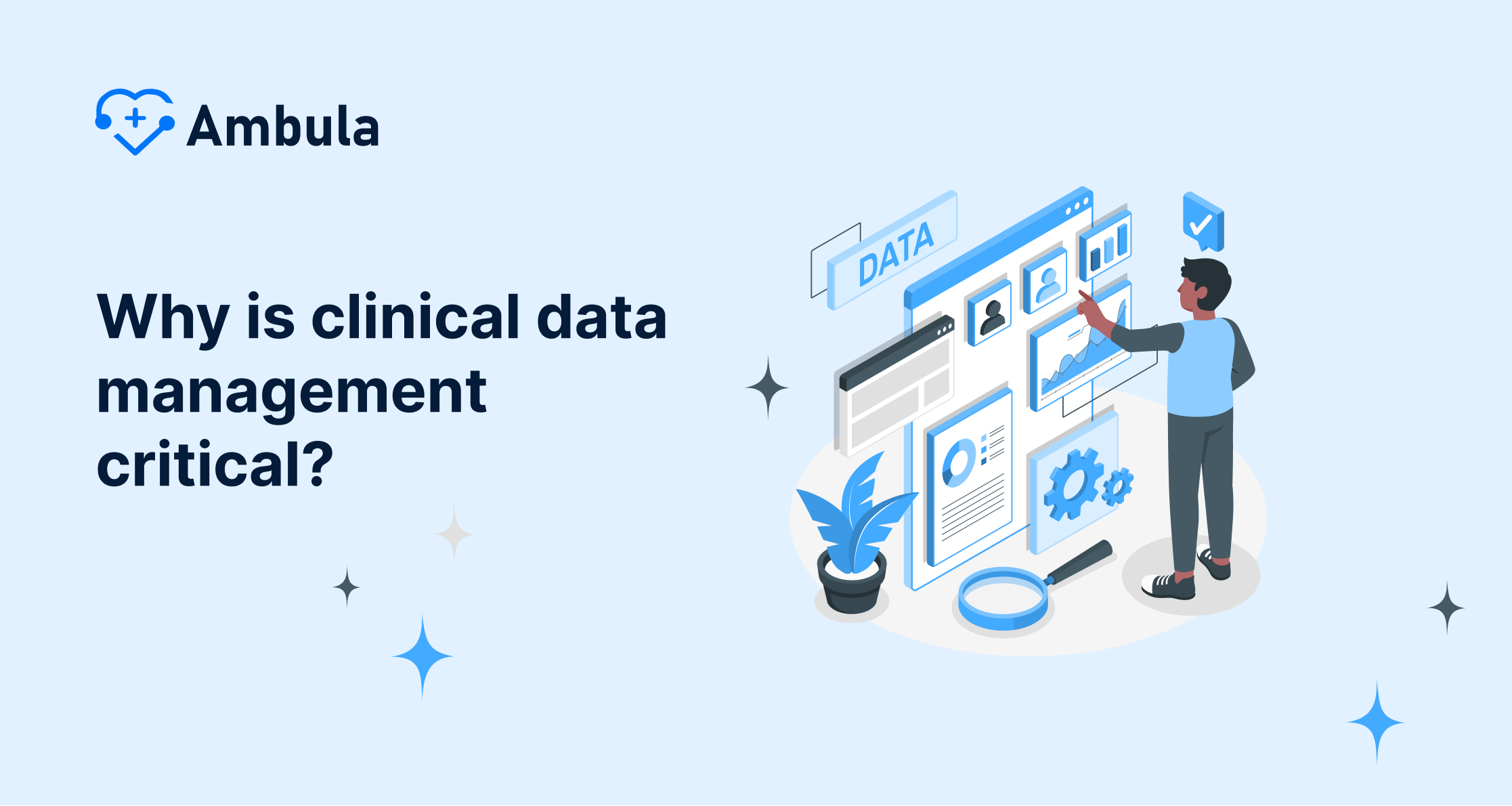
The modern healthcare ecosystem is increasingly dependent on the effective collection, management, analysis, and interpretation of data. Data management in healthcare is now the new lifeblood of the industry, influencing healthcare delivery, policy-making, and innovation. Therefore, healthcare providers must adhere to best practices in clinical data management (CDM) to ensure compliance with regulations and enhance clinical research, improve patient care, and streamline operations. This article delves deeper into the understanding of good clinical data management practices, their significance, and implications in modern healthcare.
What is clinical data management?
Clinical data management (CDM) encompasses a set of standards and guidelines for managing clinical trial data management based on best practices and regulatory requirements from authorities such as the US Food and Drug Administration (FDA) and the International Conference on Harmonisation of Technical Requirements for Registration of Pharmaceuticals for Human Use (ICH). The clinical data management definition covers various aspects, including study planning and design, clinical database management, data collection, data entry and processing, clinical data management workflow, clinical data management process, clinical data quality assurance, data analysis and reporting, and data archiving.
Data manageialscovers all aspects require CDM ofclinical research data management, including:
- Study planning and design
- Data collection
- Data entry and data processing
- Data integrity and quality assurance
- Data analysis and reporting
- Data archiving
Why is clinical data management critical?
Clinical data services are important for several reasons. First, it helps to protect the safety of trial participants. Clinical data managers can identify potential safety risks early on by ensuring that data is collected and analyzed accurately. This allows trial sponsors to take appropriate action to protect participants and to prevent serious adverse events.
Second, CDM helps produce reliable results that can be used to make informed decisions about developing new medical products. By following clinical data management guidelines, clinical data managers can ensure that data is complete, accurate, and consistent. This allows researchers to draw valid conclusions about the safety and efficacy of new treatments.
Finally, CDM is required by regulatory authorities. The FDA and ICH require clinical trial sponsors to follow CDM protocol specifications to obtain marketing approval for their products.
Key elements of clinical data management
The key elements of CDM include:
- Quality control: Clinical data managers must implement a robust data quality assurance plan to ensure that data is collected, processed, and analyzed accurately. This includes developing and implementing data standards, performing audits, and reconciling discrepancies throughdiscrepancy managementanddata clarification forms.
- Documentation: Clinical data managers must document all aspects of clinical data management, including study procedures, data collection forms, and data analysis plans based on GCDMP guidelines. This documentation is essential for ensuring compliance with regulatory requirements and facilitating the audit trail.
- Data security: Clinical data managers must implement appropriate data security measures to protect the confidentiality of trial participant data. This includes storing data in secure locations and restricting access to authorized personnel only.
The Five Stages of Clinical Data Management
Clinical Data Management (CDM) is a structured process that ensures the integrity, accuracy, and reliability of data collected during clinical trials. This process is divided into five key stages, each critical for maintaining data quality throughout the lifecycle of a clinical study. Understanding theclinical data management workflowis essential for effectiveclinical data services.
1. CRF Design
The first stage in CDM is the design of the Case Report Form (CRF). The CRF is a specialized document used to collect data from clinical trial participants. It is meticulously designed to capture all relevant data points required for the study, ensuring that the data collected is consistent and comprehensive. This stage involves identifying the types of data needed, the format for data entry, and any specific instructions for completing the forms. A well-designed CRF is crucial for accurate data collection and subsequent analysis.
2. Database Design
Once the CRF is designed, the next step is to create a database that can efficiently store the collected data. The database must be structured to accommodate all the data fields from the CRF, allowing for easy data entry, retrieval, and analysis. This stage involves setting up the database architecture, including tables, fields, and relationships between different data elements. A robust database design ensures that data is stored in an organized and accessible manner, facilitating smooth data tracking throughout the study.
3. Data Mapping
Data mapping is the process of aligning the data collected from various sources and formats into a unified database system. This stage ensures that data from different CRFs and other sources are accurately integrated into the database. Data mapping involves defining how data fields from the CRFs correspond to the fields in the database and creating protocols for data entry and validation. This stage is critical for maintaining the consistency and data integrity of the data, as it allows for continuous and seamless data extraction and reporting.
4. Study Conduct
During the study conduct stage, ongoing activities related to data collection and management are carried out. This includes real-time data entry, quality control checks, and cleaning to ensure the data remains accurate and reliable. Clinical data managers monitor the data for inconsistencies or errors and take corrective actions as needed, often using clinical data management systems (CDMS). This stage also involves managing serious adverse events (SAEs) and other potential issues that arise during the study, ensuring they are documented and addressed promptly.
5. Study Closeout
The final stage of CDM is the study closeout, where the database is finalized and locked. Once all data collection and entry are complete, a comprehensive data review is conducted to ensure the accuracy and completeness of the data. After resolving any discrepancies and ensuring that the data meets all regulatory requirements, the database lock is performed to prevent any further changes. This stage culminates in the preparation of the final study report, which summarizes the study findings and is used for regulatory submissions and other purposes.
The Vital Role of Data Management in Clinical Research
Data management stands as an essential pillar in the realm of clinical research, directly impacting the success of clinical trials and shaping the development of life-saving treatments. Here’s howclinical data servicesplay a vital role:
Guaranteeing Data Quality and Integrity: Imagine a clinical trial with inaccurate or incomplete data. The entire study’s foundation crumbles, leading to misleading conclusions and potentially harming patients. Effective data management safeguards against such scenarios by:
- Establishing clear guidelines and procedures: A well-defined Data Management Plan (DMP) outlines how data will be collected, stored, and analyzed, ensuring consistency and compliance throughout the research process.
- Implementing robust data collection methods: Utilizing standardized forms, electronic data capture systems, and data validation procedures minimizes errors and inconsistencies.
- Performing regular data cleaning and monitoring: Data managers identify and rectify errors, outliers, and missing data points, ensuring the final dataset is reliable and reflects reality accurately.
Facilitating Regulatory Compliance: The clinical research landscape is heavily regulated to protect patient safety and data privacy. Efficient data management helps navigate these regulations by:
- Adhering to Good Clinical Practice (GCP) guidelines: These international standards ensure the ethical conduct of clinical trials and the quality of data collected.
- Meeting specific country or regional regulations: Additional local requirements also apply, and data management practices must adapt accordingly.
- Maintaining meticulous documentation: Clear and auditable records of data collection, storage, and analysis are crucial for regulatory inspections and approvals.
Studies about data clinical data management
- Error Rates: Studies suggest clinical trial data can have error rates ranging from 20% to 60% without proper data management [source: Association of Clinical Research Organizations (ACRO)]. This highlights the importance of CDM in ensuring data quality.
- Cost Impact: Poor data quality due to inadequate data management can significantly inflate clinical trial costs. Estimates suggest it can add 20-30% extra expense [source: Tufts Center for the Study of Drug Development].
- Trial Delays: Data management issues are a major contributor to clinical trial delays. A study by the Parexel International Corporation found that 40% of trial delays are caused by data management problems [source: Parexel International Corporation].
Tools and Systems for Clinical Data Management
Efficient CDM depends on the use of sophisticated tools and systems that ensure data accuracy, integrity, and compliance throughout the lifecycle of a clinical trial. One of the most vital tools used is a Data Management Plan. The data management plan is a formal document that details all of the tasks, protocols, and standards necessary for managing clinical research study data. It has important sections such as milestones, deliverables, timelines, adherence to industry-specific data standards like the CDASH standard, and others. It will serve as a guiding document that is dynamic enough to develop with the study to ensure that all key stakeholders are aligned and that the standard practices of data management are maintained throughout the study. The DMPs, built into the quality management system documentation through controlled templates, will support the standardized and efficient approach through many studies.
Tools and Systems for Clinical Data Management
Efficient CDM depends on the use of sophisticated clinical data management systems that ensure data accuracy, integrity, and compliance throughout the lifecycle of a clinical trial. One of the most vital tools used is a Data Management Plan. The data management plan is a formal document that details all of the tasks, protocols, and standards necessary for carrying out the management of clinical research study data. It has important sections such as milestones, deliverables, timelines, adherence to industry-specific data standards like the standard and CDASH, and others. It will serve as a guiding document that is dynamic enough to develop with the study to ensure that all key stakeholders are aligned and that the standard practices of data management are maintained throughout the study. The DMPs, built into the quality management system documentation through controlled templates, will support the standardized and efficient approach through many studies.
Clinical data management roles and responsibilities
Effective Clinical Data Management (CDM) relies on a coordinated effort among various professionals, each playing a crucial role in ensuring the integrity and quality of clinical trial data. The clinical data management roles and responsibilities are distributed among several key roles, each with specific duties that contribute to the overall success of the study.
Clinical data manager(Project Manager)
The clinical data manager, often referred to as the Project Manager, is responsible for overseeing the entire CDM process. This role involves supervising the CDM team, coordinating data management activities, and ensuring that data collection protocols are adhered to throughout the study. The clinical data managerplays a pivotal role in discussions about data collection strategies and is responsible for ensuring the accuracy and integrity of the study data. Additionally, they handle data validation processes and are accountable fordatabase locks to prevent unauthorized changes to the data.
Database Programmer/Designer
The Database Programmer or Designer is tasked with creating and managing the study database. This role involves performing Case Report Form (CRF) annotations, designing data entry screens, and programming edit checks for data validation. The Database Programmer ensures that the database structure supports efficient data entry and retrieval, and they validate edit checks using dummy datasets to ensure accuracy before real data entry begins.
Medical Coder
Medical Coders are responsible for coding clinical data, such as adverse events and medical histories, into standardized formats. This process allows for consistent and accurate data analysis. Coders use established medical coding systems to translate clinical information into codes that can be easily analyzed and compared across studies.
Clinical Data Coordinator
The Clinical Data Coordinator designs the CRFs and creates guidelines for CRF completion. They develop protocols for managing data discrepancies and ensure that data collection is consistent with study requirements. The coordinator’s role is crucial in maintaining the quality and consistency of data collected during the study.
Quality Control Associate
Quality Control Associates are responsible for checking the accuracy of data entry and conducting regular data audits. Their role ensures that data entered into the database is correct and free from errors. They perform quality control checks throughout the study to maintain high standards of data integrity.
Best practices for clinical data management
Despite the challenges, several best practices can help organizations implement GCDMP effectively. These include:
- Use standardized procedures: Develop and use standardized procedures for all aspects of clinical data management, from study planning and design to data archiving. This will help to ensure consistency and accuracy.
- Utilize technology, such as clinical data management software, to automate tasks and improve efficiency. This can help to reduce the workload on staff and free up their time for more complex tasks.
- Invest in training: Provide training on clinical data management best practices and regulatory requirements for all staff involved in clinical data management. This will help to ensure that everyone is on the same page and that data is managed consistently.
- Implement a quality management system: Establish a quality management system (QMS) to monitor and improve the performance of the clinical data management process.
Conclusion
In conclusion, clinical data management is the cornerstone of modern healthcare, shaping critical aspects ranging from clinical trials and patient care to policy-making. Upholding good clinical data management practices ensures effective and reliable healthcare delivery. An organization’s commitment to these practices is the linchpin in enhancing patient trust, ensuring individual patient safety, improving treatment outcomes, and, overall, casting a positive impact.









